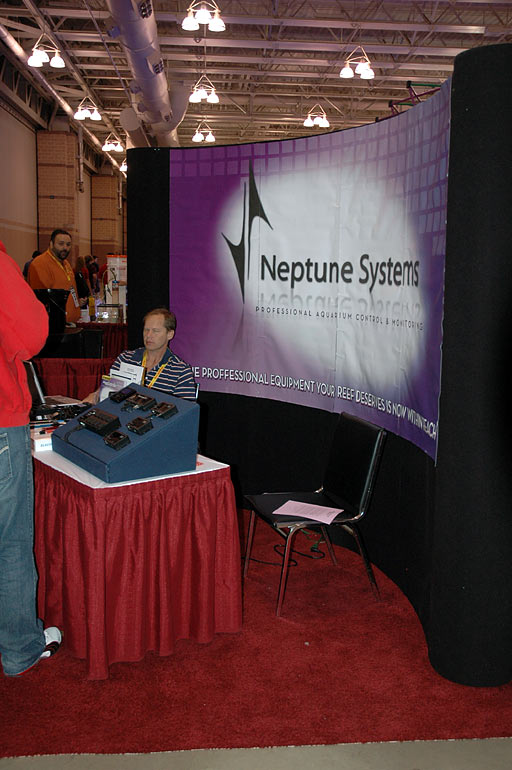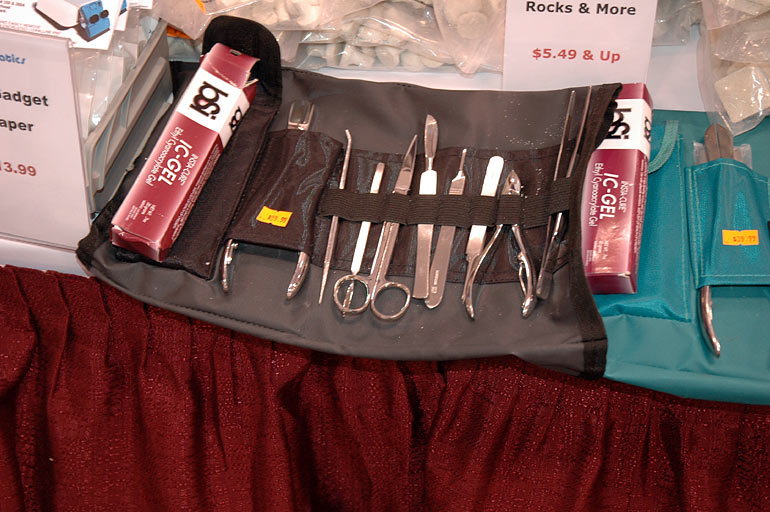MACNA XXI
Page 2
Here are a few pictures from the vendors I remembered to take pictures of.
That's Curt from Neptune's Systems. I thought I got him smiling, but you never know until you get back to your main computer. He was there to promote the APEX controller.
Randy from Reef Nutrition
Andy from Teco posing oh so pretty. :D
The innards of a Teco chiller
 I chatted with Andy yet again about my desire to purchase a chiller that is only plumbed in for emergency management. It would only come on in an extreme situation, like if my tank hit 85F and had to be protected from the resulting devastation of elevating temperatures. Unlike how most people use a chiller to lock in the temperature around the clock, I wouldn't want it to cycle on unless all else had failed.
He showed me a 1/3 HP chiller that he felt would do the job of keeping it at 85F or even dropping it some, but I couldn't possibly get a 10F drop in temperature with that size. It would require a bigger version. Since I'm looking for a two or three degree drop, this one would do it. https://www.tecous.com/product/seachill-tr20/
It is a smaller chiller which wouldn't take up much space. I thought I could plumb it into the garage, but Andy felt if I was having heat problems, the last thing I'd want is a chiller sitting in a hot garage trying to save the tank. My concern was a chiller that is hardly used sitting in a fishroom and the resulting environment harming it over time. Although if you think about it, they are built to withstand it I suppose.
Rod from Rod's Food
Two Little Fishies had a new bigger Phosban Reactor on display.
Pacific East Aquaculture
Deltec had a great booth like every year. If you needed salt, they had it.
Their skimmer's have changed colors. Now they are made with white material instead of the black we are used to.

 Deltec has a nice denitrifying reactor that runs with Vodka instead of sulfur, and I'm very interested. Marvin and another gentleman took the time to discuss how it works, and I'm leaning toward buying on. Here's the link: http://www.theaquariumsolution.com/?q=node/295
The way it works, it has some mesh media within for the anerobic bacteria to colonize. Vodka is injected daily with a dosing pump that pushes 1ml per minute. If the reactor needed 15 ml, it would run for 15 minutes, if less ml, less minutes. That's pretty easy. For some reason, they recommend diluting the vodka with some water, and the only reason that makes sense to me is if I'm trying to inject 6.5 ml instead of a rounded number. With the dilution, you can use math to time it the right amount of minutes and dial it in perfectly.
The reactor I'd use would be one rated for 200g of water. I'd rather it be underrated rather than too large. The next size up is for 500g of water.
The next thing you need to know is that the entire display's water volume passes through the reactor and an incredibly slow rate. One drop every three seconds is what was recommended when setting it up. Essentially, the display's water volume should pass through the reactor over 14 days only once. Super slow, right?
So why bother? Why not continue just putting in 15 ml per day by hand? Well, when I'm here, that's no problem. When I'm out of town, I rely on my son to do it. There's always the chance he isn't doing it - you really never know unless the parameters prove it... if you have kids, you know what I'm saying here. ;)
The other reason the reactor is a better method is because you put the vodka in the reactor, not the tank. Each day it gets its dose, but the tank hardly ever does since the turnover rate is so incredibly slow. Just throwing out an example, the reactor may only need 6ml of vodka per day that feeds the oxygen-deprived bacteria in the reactor, which drips out ever so slowly. Currently, I'm adding 15ml per day directly to the tank itself. To me, it seems like this automated way would also be a safer way because I"m controlling a single spot and for the most part not dosing the tank at all. The bacteria in the reactor consume the nitrate. Having it do this automatically takes away the need for me to have anyone add it. A simple jug would be connected to the dosing pump that pushes it into the reactor, each time the Aqua Controller 3 tells it to daily.
I've also played with the idea of just buying the dosing pump by itself, and have it turn on for a fixed number of minutes a few times a day to add it to the sump. I could have it turn on for one minute every hour for 15 hours, for example.
I ran into the owner of http://glassbox-design.com/ and talked with him about this idea. He's been dosing with VSV, with only vodka, and currently has something else up his sleeve. I wanted to know what he thought about Eric Borneman's concerns about the risk of creating a mono-culture in the reef that leads to its demise, and if it might be good to dose with various products like Prodibio or Reefresh to keep varied colonies thriving. We also talked about the possibility of vodka (mixed with water) separating over time, as well as how the neoprene or silicone tubing would hold up with ethanol-based fluid passing through it on dosing pumps.
We reefers really do take things to a whole new level at times.
Boston Aqua Farms - I heard they had a bunch of new fragging tools that hold up better to our saltwater environment.
Champion Lighting was there. Their booth didn't have much to see, although they had their strange SCWD-Skimmer gizmo going again since it makes people walk over.
CaribSea had their goodies on display
Aquatic Auction had some colorful corals available, and you could bid on the spot from various booths that had laptops set up.
If you got hungry, you could play black jack to win a cup cake. Even if you lost, you left with a smile.
This is the CO2 scrubber. Premium Aquatics carries it. Refills are $30.

A new product that was being discussed is this CO2 Scrubber, which Premium Aquatics carries. http://www.premiumaquatics.com/aquatic-supplies/MCU-CO2.html
In our homes, CO2 levels rise up due to the house being sealed tightly against cold winters and hot summers. We want to ease out electric bills with better insulation and better windows, but the lack of fresh air drives the pH down in our tanks. The way this product works, air is passed through the media, removing carbon dioxide. It is connected to the venturi intake tubing of our protein skimmer. The result is that pH will rise in the tank within about 8 hours of using it.
If you have a club function in your home and a bunch of mouth breathers fill the fish room up with CO2, the scrubber would keep your tank safe from a depressed pH level. If your tank suffers from lowered pH on a regular basis, this might be of value. For me, I'm not too worried about it. My tank ranges from 8.1 to 8.3 each day, but would probably run at 8.3 to 8.5 with the scrubber inline.
Since I have a lot of stuff on hand, I could technically build my own and only order the CO2 media cartridge just to see what it does. The question of course is how long will the media last? It changes to a deep dark purple color. I asked how it would hold up in a damp fishroom (late night in the summer is when this is most prevalent) and was told that was perfect. In arid environments, the instructions recommend adding a teaspoon of water to the reactor because it needs a little moisture.
I don't know if the skimmer would be more efficient or not - its another one of those things I'd like to try just to know what happens, to have some solid answers.
One booth was from an online store, and he had everything you could imagine. I can't recall their name, but it was something like TB Aquatics. A tidy Fragging Kit caught my eye
Some H&S Skimmers
Icecap has a new light fixture that should be pretty competitive, pricewise. There are two kinds. One uses LEDs (that look like a T5 bulb) & T5s, and the other one holds two 250w DE bulbs, two T5s, two LEDs, and moonlights.
This is the fixture with the MH bulbs.
Reef Brite is a new company that Joy Meadows has started up. Earlier this year, she revealed the new dual metal halide bulb that can run one of two colors. Each time it turns on, the opposite bulb within turns on. Originally, I thought it was 10,000K and 20,000K, but now she has bulbs that are 10,000K / 10,000K, 20,000K / 20,000K, and I think she said something about 14,000K or 15,000K. Her reasoning for having two of the same color in that bulb is that you wouldn't have to change them as often since each 'side' only gets used half the time. Odds are this will be popular for public aquariums and people with huge tanks that can't access the lighting readily.
This fixture was pretty neat, all LED lighting over the Aquatic Auction tank. It is a series of very thin-profiled aluminum housings that are all connected in a row to a solid frame. I doubt it was more than 1" tall.
This last fixture is a MH pendant with LED outriggers.
|






























